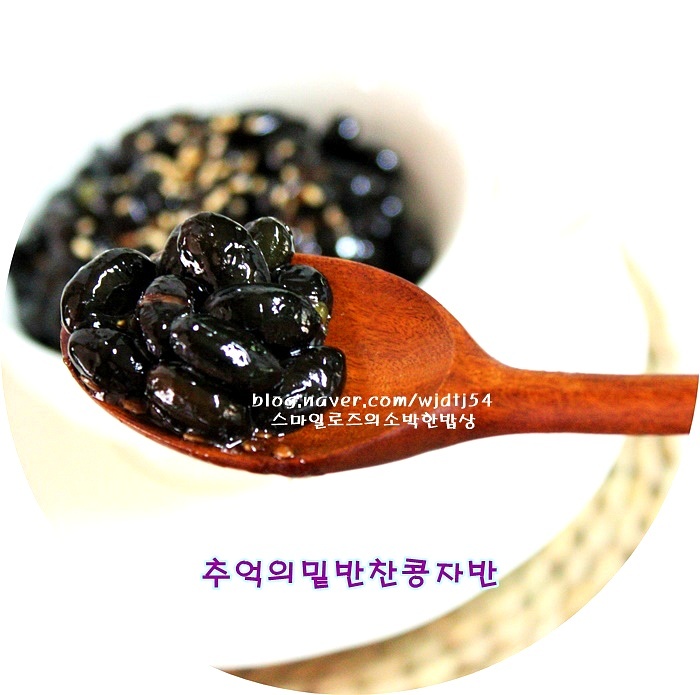Soft Braised Black Beans (Kongjaban)
Nostalgic Kongjaban for Summer: A Delicious and Soft Recipe

This recipe introduces how to make Kongjaban, a nostalgic side dish from childhood, in a soft and not-too-salty way. Enjoying both the health benefits of black food and the taste of yesteryear, Kongjaban is perfect as a side dish for rice or even as a hearty meal. Even if you have sensitive teeth, you can enjoy this glossy, soft Kongjaban recipe and revive your appetite this summer!
Ingredients for Braised Beans- Black beans (soaked) 2 cups
- Flax seeds 2 Tbsp
- Kelp (10cm x 10cm square) 1 sheet
- Water from soaking beans 1/2 ~ 1 cup
Seasoning Ingredients- Savory soy sauce (Guk-ganjang or Jin-ganjang) 1/2 cup
- Dashi stock 1 cup
- Sugar 2 Tbsp
- Oligosaccharide 1 Tbsp
- Sesame oil 1 Tbsp
- Toasted sesame seeds a little
- Savory soy sauce (Guk-ganjang or Jin-ganjang) 1/2 cup
- Dashi stock 1 cup
- Sugar 2 Tbsp
- Oligosaccharide 1 Tbsp
- Sesame oil 1 Tbsp
- Toasted sesame seeds a little
Cooking Instructions
Step 1
First, wash the black beans thoroughly. Soaking them in water the night before makes them ready to use the next morning. In summer, soak for 3-5 hours; in winter, soak for more than 8 hours to ensure they are well-softened. (If you plan to grind the beans, you can soak them with about twice the amount of water and refrigerate.)

Step 2
When you wake up in the morning, the black beans will be nicely plumped, with only a small amount of water remaining. You can use these soaked beans for braising.

Step 3
Add the kelp to the water when soaking the beans and refrigerate it together. This kelp will add umami to the braised beans.

Step 4
Pour 1 cup of dashi stock into a wide pan, add 1/2 cup of savory soy sauce and 2 Tbsp of sugar. Bring to a boil over high heat, then reduce to medium-low and simmer.

Step 5
Skim off any foam that rises to the surface as it simmers. This helps to create a cleaner broth and remove any unwanted odors.

Step 6
Add the soaked black beans, flax seeds, and the kelp you soaked together to the simmering sauce. Braise gently over medium-low heat until the beans are soft. If you prefer firm Kongjaban, lightly pan-fry the beans first before adding the sauce and simmering. However, for soft Kongjaban, add the beans to the sauce after it has reduced slightly, and simmer until thoroughly cooked. Adding 1 Tbsp of oligosaccharide at the end will give it a glossy finish, making the Kongjaban look very appetizing. (If you prefer it sweeter, add more sugar or oligosaccharide to your taste.)

Step 7
Once the sauce has reduced and the beans are tender, turn off the heat. Stir in 1 Tbsp of sesame oil and a sprinkle of toasted sesame seeds. Transfer the braised beans to a serving container.

Step 8
Your delicious, glossy Kongjaban is ready! The nutty flavor and soft texture are exceptional. This homemade Kongjaban offers a different charm compared to the hard versions from childhood, captivating your taste buds.

Step 9
Although I didn’t used to like Kongjaban when it was packed in my lunchbox, making it myself now makes it taste wonderfully new and delicious! It’s a dish I find myself reaching for often, as it’s both healthy with black beans and incredibly tasty. I’ve been using the black soybeans (Seoritae) I bought last fall to sprout bean sprouts, add to rice, and enjoy in various ways.

Step 10
The Kongjaban I made after a long time is a satisfying side dish on the table. I highly recommend it as a special treat when your appetite wanes during the summer!

Step 11
This Kongjaban is excellent as a side dish for children and as a summer staple. With the weather cooling slightly, I’ve been preparing a few side dishes and rotating them. This Kongjaban is one of them, providing a hearty and satisfying meal.




